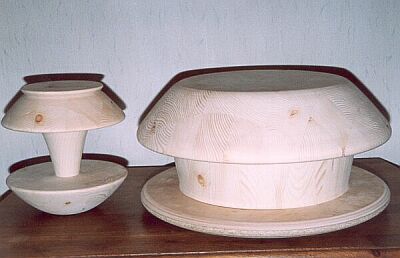|
Houten Objecten van Rik Mars |
|
|
|
|

|

|

|
3-dimensional alphabet by Esther Ermers |
|
As final project for het study at the Design Academy Eindhoven, department of Industrial Design, Esther Ermers
thought of a 3-dimensional alphabet. Hand-written letters are rotated around a vertical
axis, so round objects are created.
Esther Ermers asked woodturners to turn the 3-dimensional letters for her. They had to become stools for a library.
The dimensions vary from almost 30 to about 60 cm in diameter and from 30 to 90 cm in height. The letters were to
be painted after completion. The type of wood was of no importance. I made the r (relatively small with 28,5 x 30 cm) and the m (diameter 59 cm, height 30 cm).
I composed the objects out of whitewood, from timber square 7 cm. Especially the m needs a To use less wood and to have to turn away less and not to make the work pieces any larger than necessary, I composed the letters out of parts. Observing the shape of the r and the m it is obvious: a large hood and foot and a smaller body in between. With tenon and mortise joints the parts are put together. The mortises are at the same time the mounting for the fine turning.
The making of the letters starts with glued together, first into rows, that the rows into a block. I did so
on a plane surface and between solid timber to prevent any deviation in measurements. After that I could put the block on the lathe. The hood and the foot I first screwed on a faceplate, the screws outside the wood that will become the letter. I turned the outside clean and made the mortise to size. With an adapter in the size of the mortise I could turn the hood or the foot around and machine it further to its size. I was given drawings scale 1:1 with inscribed measurements. The advantage of the flat top and bottom of the pieces is that I could measure easily, without the need of a vernier calliper of 30 or even 60 cm. Further I could copy the shape from the drawings to a template, with which I could monitor the sizes. The body I turned between the centres. The tenons to the left and to the right to fit into the mortises of the foot and the hood and further to the measurements given. This was the r. The m was a quiet different story. What has to become a diameter of 59 cm is unmachined a polygon of 63 cm. That is quiet something on your lathe. But if you are used to turn trunks of trees of considerable diameter, this is a piece of cake. It is balanced from the very beginning. The speed of the lathe is put very low of course (400 rpm), for the cutting speed is big enough.
Also I decided it to be useless to make a round tenon and mortise jount. That just costs wood and work. It became a
square tenon of in total 9 blocks (21 cm square) and a big hole through
In stead of composing the relatively thin (49 mm) foot of the letter m out of blocks I decided to compose it from
plates. chipboard and plywood. Discs I cut in a trough size and glued them together. The square mortise I saved in the
middle.
As an adapter for centring the pieces I use square plates of plywood, screwed onto the faceplate.
After turning and sanding, all there was to do is glueing the parts together
Esther Ermers could come along to collect them. Project finished. 2004 |
|

|

|

|

|